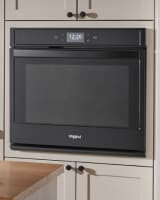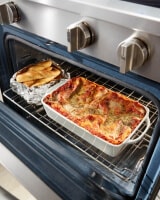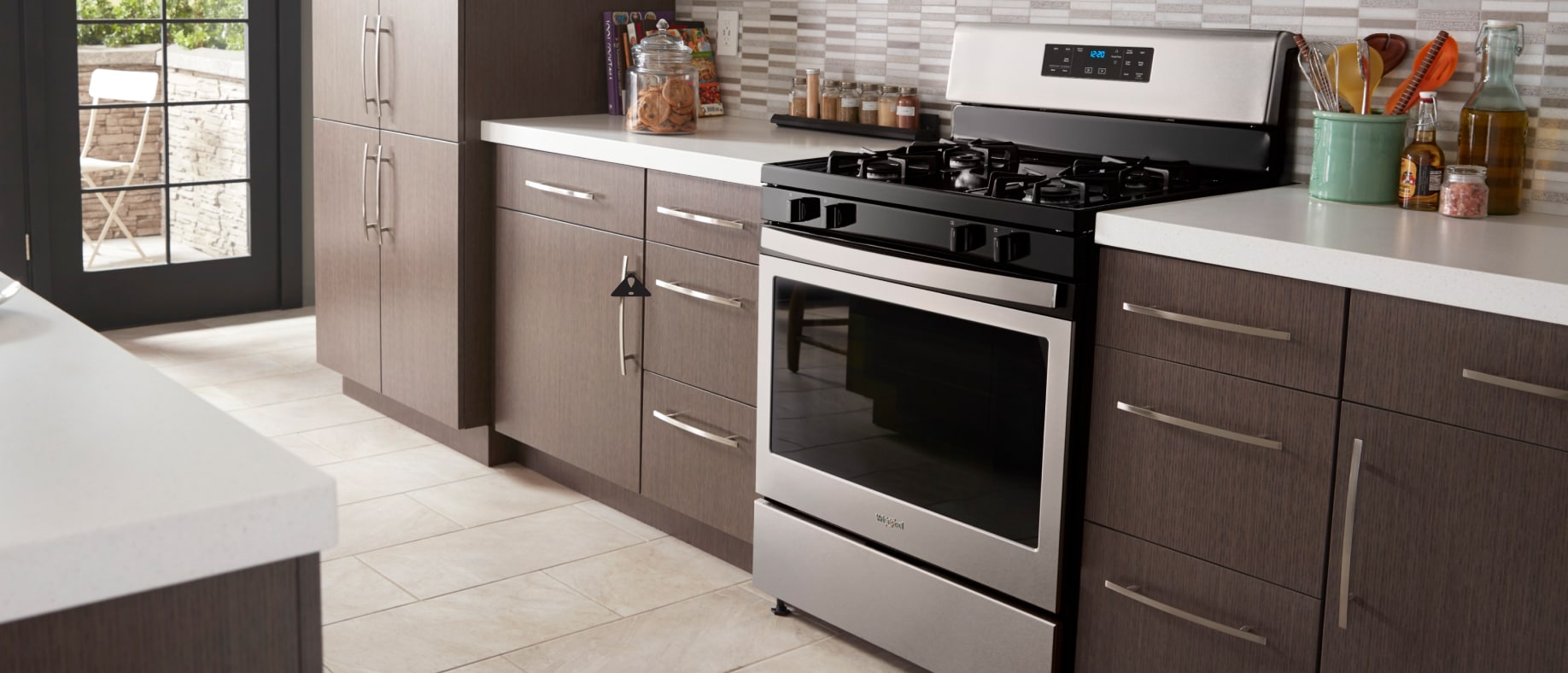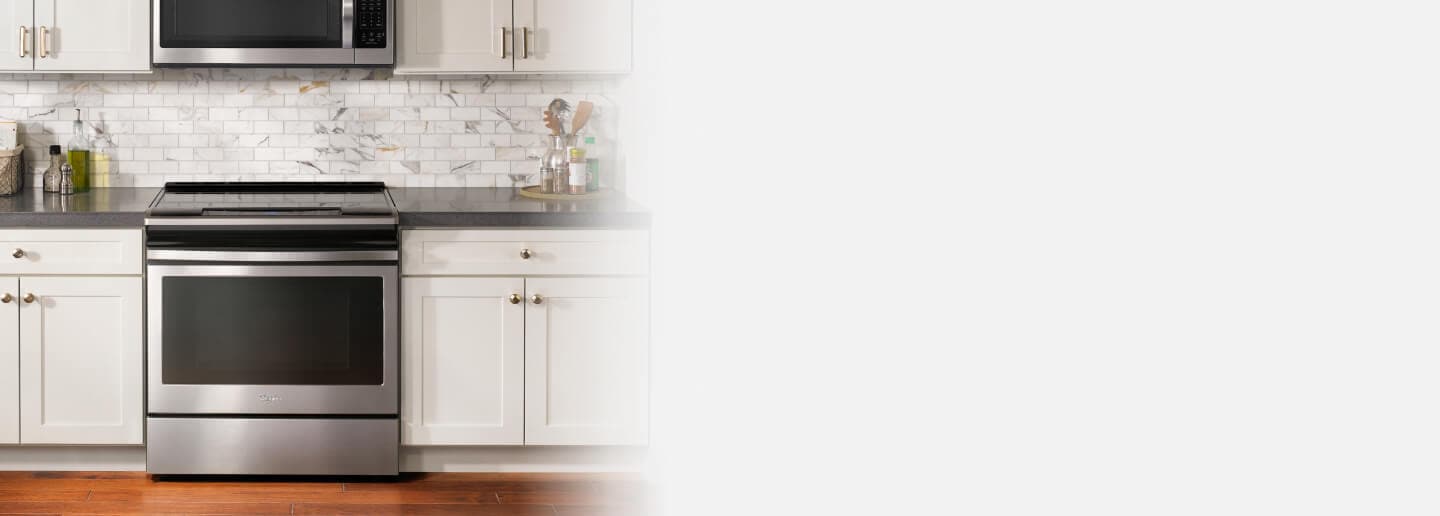
How does a self-cleaning oven work & how do you use it?
If you’ve noticed that your oven has a self-cleaning feature but you’re not quite sure what that means or how to use it, this article will break down how a self-cleaning oven works, how to properly use it, and answer some of the most frequently asked questions regarding the function and proper use of a self-cleaning oven.
How does a self-cleaning oven work?
In short, a self-cleaning oven uses either high temperatures or steam to help remove any residue and food leftover from previous baking or roasting. Steam cycles are designed for light soils "between" cleanings, while high temperature self-cleaning is meant to reduce soil with varying cycle lengths. A self-cleaning cycle can last anywhere from 1.5 hours to 3 hours, depending on the level of soil that your oven has.
For traditional self-cleaning ovens that use high heat, temperatures will reach upward of 800ºF, which helps incinerate any leftover food and stuck-on grime, turning into ash that can be wiped away with a wet cloth. For ovens that use steam clean, the cycle tends to be a lot shorter—around an hour for cleaning and cooldown, and temperatures typically max out at 400ºF depending on the location in the oven. Like with a high temperature self-cleaning cycle, you'll need to wipe away any residual water and soil with a wet cloth after steam cleaning.
How long does it take an oven to self-clean?
The self-cleaning cycle that you choose depends on the level of soil. On average, high heat self-cleaning ovens require anywhere from 1.5 hours to 3 hours, and even 6 hours on some models. For ovens that use a steam-cleaning feature, cycle times are generally shorter, under an hour for cleaning and cooldown.
Some oven models, like this range available from Whirlpool, have adjustable self-cleaning settings, which allow you to pick a cycle based on the level of soil your oven has, from light, to moderate to heavy soils.
How to prepare your oven for a self-cleaning cycle
Follow the instructions in your owner’s manual to use and prepare your self-cleaning oven properly. To ensure that everything goes off without a hitch, remove any pots, pans or aluminum foil that you may have in the oven, and wipe away any visible debris or spills prior to starting the cleaning cycle.
Additionally, make sure that your oven vent is uncovered, and turn on the exhaust fan of your range hood so that any unpleasant fumes can be ventilated to the outside, and/or open up any windows to keep the kitchen well-ventilated.
Can you leave the house while the oven is self-cleaning?
Do not leave your oven unattended while the self-cleaning function is on. Since the oven will reach extremely high temperatures that may cause some slight smoke or fumes, staying close by is suggested.
Additionally, if you have pets, you’ll want to make sure that the kitchen is well ventilated and keep them in a separate room while the oven is self-cleaning, as their senses of smell are more sensitive than ours.
How often should you use the self-clean oven function?
The frequency you use the self-clean function truly depends on how often you use your oven and the level of soil that it gathers over time. Generally speaking, the self-clean function is meant to provide a heavier duty clean. It is best to run the cleaning cycle before excessive soils accumulate to avoid excessive smoke and fumes during oven cleaning.
What’s the difference between a self-clean and steam-clean oven?
Self-cleaning ovens use high heat to help burn any residue or soil left behind in the oven and turn them into ashes, while steam-cleaning ovens use water to soften stuck on food particles. High heat self-cleaning cycles are typically longer than steam-clean cycles, and require a locked oven door as a precaution.
With steam-clean, temperatures are usually within typical bake range or around 400 ºF or less, and the oven does not lock, though it may require a more thorough wipe down at the end of the cycle than high heat self-cleaning ovens. Dive deeper into the differences between self-clean and steam-clean ovens to learn more.

Compare self-clean and steam-clean ovens
Read Article

Compare different types of ranges
Read Article
Can you clean a self-cleaning oven manually?
You sure can. While a self-cleaning or steam-clean oven is meant to provide a helping hand to make the job of cleaning an oven less arduous, you are not required to use this function to thoroughly clean your oven. In fact, even ovens that have self-cleaning functions require manual cleaning, especially of the oven door glass, from time to time. You can use mild soap and water to wipe down your oven in between heavy duty cleanings.
How to use a self-cleaning oven
Use these self-cleaning oven instructions to get your oven looking great.
Step 1: Prepare the oven for self-cleaning
First, remove everything (including racks) from your oven. Since the oven will reach extremely high temperatures, any leftover residue left on the racks can cause excess smoke and racks can become damaged in the high heat. On ranges, make sure there's nothing on the cooktop or in the storage drawer. Wipe the interior and frame with a damp cloth, avoiding the gasket (the inner seal of the oven door) so it will close properly.
Cleaning tip: To self-clean less often, clean up baking spills right after they happen. Dilute a little mild hand-wash dish detergent, baking soda or lemon juice in water. Use a clean cloth to scrub your oven with one of these cleaning solutions.
Step 2: Select a self-clean option
Select a cleaning setting, following recommendations from your self-cleaning oven instructions. Some ovens, including Whirlpool® Self-Cleaning Ovens, have settings for light, moderate or heavy soil. A light cleaning setting may last around 2 hours, while moderate or heavy soil settings can last closer to 3 or 4 hours.


Step 3: Start the self-clean cycle
In order for the self-cleaning cycle to start, the door must be closed. Next, your oven will lock and heat up to a very high temperature. The high heat reduces stuck-on food and grease to ash in a process called pyrolytic cleaning. Your oven will stay locked and a fan will run until it cools. A cycle on a Whirlpool® Range can take anywhere from 2.5–4.5 hours, while a wall oven can take 2-4 hours or longer.
Even though self-cleaning ovens have extra insulation to help handle heat, it’s important to keep children away, and no one should touch the oven while it cleans. Failure to follow these instructions can result in burns.
Self-cleaning tips:
- Always move pets, especially birds, to another closed and ventilated room or outside in a cage until cleaning finishes.
- Turn on your hood fan and open windows to make sure that your kitchen is well-ventilated during the self-cleaning cycle to help get rid of heat, odors and smoke.
- Never use commercial oven cleaners or oven liner protective coating, as these can harm your oven’s interior.
Step 4: Wipe the oven down
If using a high-heat cycle, your oven will unlock once the self-cleaning is complete and the oven has cooled down. While the oven won’t unlock until it has reached cooking temperatures, you should wait until the oven is completely cooled down before wiping it clean. A special enamel coating helps you wipe away the ash at the end of the cycle. This can provide a helpful alternative to manual cleaning. Heavily soiled ovens may require a longer cycle or a second cleaning cycle in order to improve cleaning.

Whirlpool® Ranges
A range for every home
Find the range you need with the design and features you love when you explore ranges from Whirlpool brand
Find the right self-cleaning oven for your family
Interested in an oven that helps make clean-up easier? Shop Whirlpool® self-cleaning ranges and self-cleaning ovens.
Shop electric self-cleaning ovens and ranges
Shop gas self-cleaning ovens and ranges


Helping kids stay in school
Learn how Whirlpool helps end the dropout cycle by giving kids access to clean clothes through the Care Counts™ Laundry Program
Was this article helpful? Pass it on
Explore more from Whirlpool brand


home heartbeat
Ready for more tips, home hacks and appliance guides?

